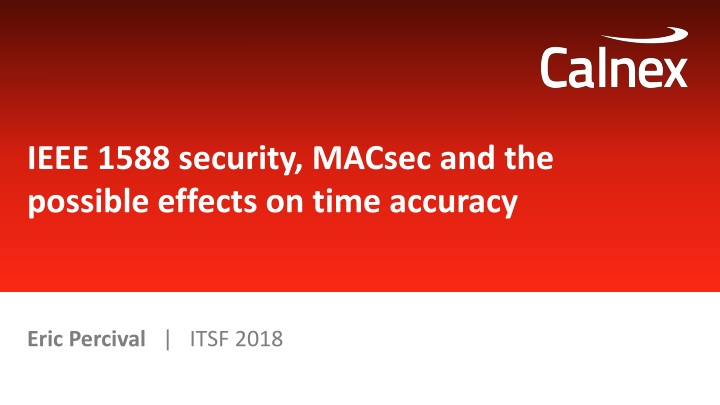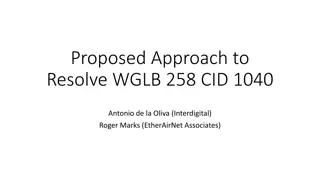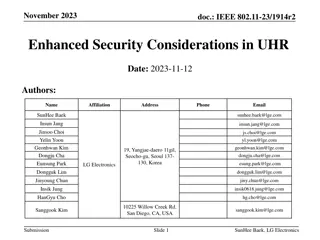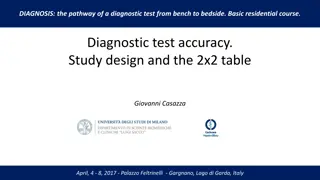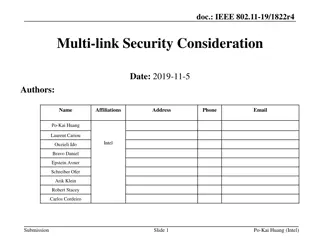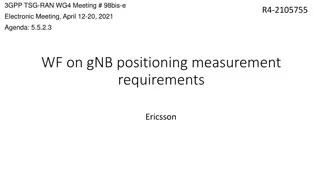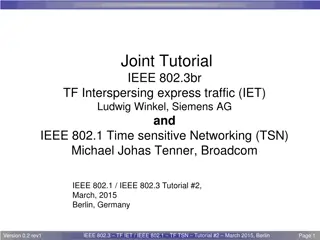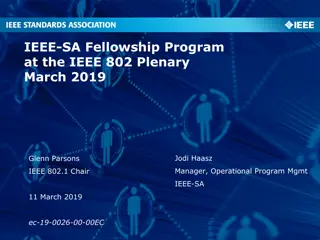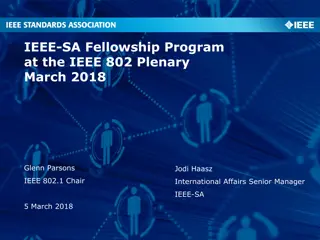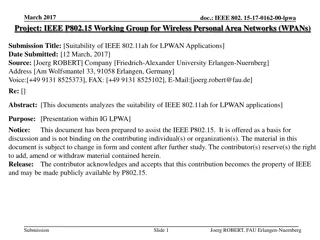IEEE 1588 Security & MACsec: Effects on Time Accuracy
The intersection of IEEE 1588 security and MACsec protocols and their impact on time accuracy. Cyber security basics, key distribution challenges, common types of attacks, and the importance of protecting PTP services are discussed.
Download Presentation

Please find below an Image/Link to download the presentation.
The content on the website is provided AS IS for your information and personal use only. It may not be sold, licensed, or shared on other websites without obtaining consent from the author.If you encounter any issues during the download, it is possible that the publisher has removed the file from their server.
You are allowed to download the files provided on this website for personal or commercial use, subject to the condition that they are used lawfully. All files are the property of their respective owners.
The content on the website is provided AS IS for your information and personal use only. It may not be sold, licensed, or shared on other websites without obtaining consent from the author.
E N D
Presentation Transcript
IEEE 1588 security, MACsec and the possible effects on time accuracy Eric Percival | ITSF 2018
Agenda Topics covered Some Cyber Security Basics Time, PTP and Security IEEE 1588 Approach to Security MACsec and IEEE 1588 2
Cyber Security Basics What is Cyber Security all about? Confidentiality Integrity Authenticity Availability Keeping things secret. Ensuring something hasn t been tampered with. Being sure about who or where something is from. Keeping items and services available to those with access rights. 3
Cyber Security Basics A few notes on security Doing good security is hard Security adds overhead It starts by assuming that the channel is insecure i.e. the bad guys have access to all transmitted information and that they can modify it. Procedures have to be followed for it to work and additional infrastructure may be required. The weakest element? In any security implementation is usually the humans. 4
Cyber Security Basics Keys and the Key Distribution Problem Encryption/decryption, authentication and integrity checking rely on secret keys Secure generation and distribution of keys One of the major challenges in cyber- security. It is a complex process. In general these should be known only to the sender and receiver. (Public keys being an exception.) Keys may need to be changed periodically A central aim is to make the cracking of keys impractical Key management is typically done using a Key Distribution Center that implements a specific protocol, e.g. Kerberos. Preventing decryption by brute force or any other more sophisticated means. 5
Cyber Security Basics Common types of attacks Replay attacks Gain access to or disrupt a service by capturing and replaying previous traffic. Attempt to steal or crack keys Either by brute force or exploiting technical weaknesses in the system. Denial of Service Prevent users from accessing the service e.g. by overloading a server with fake requests. Spoofing Pretending to be a valid service or user e.g. to steal login and password details or disrupt a real service. Social engineering Persuading people to give away their secret information through subterfuge. 6
Time, PTP and Security Why Protect PTP? Authenticity and integrity are important in PTP What sort of attacks might be made on a PTP service? Who is vulnerable? Time is not considered to be a secret so encryption is not generally necessary Denial of service, e.g. prevent time messages reaching the slave. Spoofing fake the time by pretending to be a perfect GrandMaster. Can you be sure that the message came from a valid GrandMaster and that it hasn t been tampered with? Anyone who depends on the integrity of a PTP timing service. However, other security policies on a network may lead to PTP messages being encrypted. 7
Time, PTP and Security Possible consequences of compromised PTP Financial fraud and/or chaos e.g. incorrectly timestamped transactions in high frequency trading. Factory breakdown e.g. mis-sequencing of industrial operations. Mobile phone network problems e.g. due to interference, failed handovers etc. Power blackouts e.g. due to mis-synchronisation of phasors. Television broadcast failure e.g. due to mis-timing of video and audio streams Autonomous/semi-autonomous vehicle collisions 8
IEEE 1588 (PTP) Approach to Security IEEE 1588 Standard and Security Physical security Logical security Multi-pronged approach Prevention of access to cabling and equipment is outside the scope of the standard but it is a risk e.g. insertion of different length cables can cause asymmetry and thus a constant time error. This is covered in the standard. In the new version of the standard a multi-pronged approach to security has been developed and is described in the informative Annex S. All the prongs are optional i.e. not required in a standard implementation. In the 2008 version of IEEE 1588 this was limited to an informative experimental Annex (K). As far as anyone knows, this has never been implemented and has been removed from the new version of the standard. 9
IEEE 1588 (PTP) Approach to Security 1588Rev Security the updated standard A four pronged approach is described in Annex S: Prong A Prong B Prong C Prong D Monitoring and management guidance. Authentication and integrity verification. The use of transport security. Architecture guidance. Several prongs can be applied in parallel; they are not mutually exclusive. 10
IEEE 1588 (PTP) Approach to Security Prong A Authentication TLV + Security Processing Section 16.14 of the new standard describes a TLV that can be appended to messages. The generation and validation of the ICV requires a key shared between the sender and receiver. Two processing schemes are described in the new standard: Immediate Security Processing (all intermediate and end nodes have the key in advance). This TLV includes an integrity check value (ICV) to allow validation of the source and confirm that the message has not been tampered with. The method for generation and sharing of keys is outside the scope of the standard. Delayed Security Processing (key is distributed afterwards).* * This makes it impossible for on-path elements to modify mutable fields (e.g. the correction field) 11
Msg n IEEE 1588 (PTP) Approach to Security Immediate vs Delayed Processing Msg n Msg m Msg 3 Msg 2 Msg n+2 Msg 2 Key generated Messages encoded and sent Key shared and discarded Key received and stored Messages encoded and sent Msg 1 Source Msg 1 Msg n+1 Source Source Used to encode and decode n+1 through m Msg m Msg n+2 Msg n Key Server Msg n+1 Used to encode and decode 1 through n Key generated and shared with both sender and receiver Msg n Msg 3 Msg 2 Msg 2 Msg 1 Msg 1 Messages received and stored Key received; messages decoded Key received and stored Messages received and decoded Receiver Receiver 12
IEEE 1588 (PTP) Approach to Security Prong B Transport: IPSec and MACSec PTP Grandmaster Router 1 Router 2 PTP Slave 5 5 PTP Layer PTP Layer 4 4 UDP Layer UDP Layer 3 3 IPSec Tunnel IP Layer IP Layer IP Layer IP Layer MACSec Tunnel MACSec Tunnel MACSec Tunnel 2 2 MAC Layer MAC Layer MAC Layer MAC Layer MAC Layer MAC Layer 1 1 PHY Layer PHY Layer PHY Layer PHY Layer PHY Layer PHY Layer One challenge of PTP with any security scheme is that the potentially variable delay through the encryption and decryption processes could affect time accuracy. 13
The use of MACsec What is MACsec? MACsec applies security to layer 2 within wired Ethernet networks This security can take two forms: Integrity checking only* Integrity checking and payload encryption Described in two standards: IEEE 802.1AE MAC Security Std. Describes the establishment of secure logical channels. IEEE 802.1X Key Agreement Used to share keys and establish secure associations between nodes. It uses a port based model i.e. each port on a device has a MACsec entity associated with it. * Allows packets to be authenticated as coming from the station that claimed to send them and ensures that they have not been tampered with en route. 14
The use of MACsec MACsec Concept Device 1 Device 2 Higher Layer Protocols Higher Layer Protocols Security Entity Insecure MAC Service Insecure MAC Service Secure MAC Service Secure MAC Service MACsec packets Normal packets MACsec packets Normal packets Common Insecure Port Common Insecure Port Higher layers choose whether or not to use the secure MAC service to protect packets. All data is sent through the common insecure port. 15
The use of MACsec Why do 1588 implementers care about MACsec? In PTP networks secured with MACsec there are some possible time error effects due to the implementation: Constant Time Error Constant Time Error Dynamic Time Error Due to the difference in time to encrypt and decrypt messages at a particular node. Due to asymmetry based on the choice of receive versus transmit packet timestamping point. Due to the difference in time to encrypt and/or decrypt successive messages. NOTE: It may be possible to mitigate these effects by using two step clocks but the implementation will depend upon the PHY capabilities. 16
The use of MACsec Timestamping and MACsec PTP Event Packet MACSec PHY Transmit timestamp point for one step clocks (can t modify packet after MACSec) Ideal transmit timestamp point timestamp point Ideal transmit Transmit MACSec PHY PTP Event Packet Matches transmit timestamp point for one step clocks to remove asymmetry Ideal receive Ideal receive timestamp point timestamp point Receive 17
IEEE 1588 (PTP) Approach to Security Prong C Architecture Guidance Prongs A and B are not suitable for detecting or mitigating delay attacks or device failures. Prong C proposes architectural redundancy as a solution. Redundant Grandmasters Redundant Network Paths Redundant Complementary Time Sources In case a grandmaster fails or is compromised in some way If a network path fails or is compromised e.g. extra length of cable is inserted. As well as PTP, use an additional independent time source. 18
IEEE 1588 (PTP) Approach to Security Prong D Monitoring and Management There are a number of parameters described in Annex M of the new standard that can be used for performance monitoring. By recording these and looking for unexpected values or larger than expected changes, security alerts can be generated and acted upon. 19
Insight and Innovation Summary and conclusions Good security is hard to do and tends to be complex to implement. This often means it is left until late in the development process. The new optional 1588 security TLV mechanisms require quite a bit of work and a key management system to go along with them. MACsec is complex and potentially introduces timing inaccuracy. Doing nothing leaves critical systems vulnerable to attack. A key management system is required. 20
Questions? 21
The use of MACsec The MACsec standards MACsec is described in two standards: 802.1AE Defines MACsec 802.1X Defines port level authentication and MACsec Key Agreement protocol This describes the mechanics for establishing and operating secure logical channels that perform integrity checking and optionally encryption between nodes on a wired LAN. This is optional but typically implemented alongside 802.1AE. It is used to establish secure associations between nodes. Without it key sharing and management is manual or has to be done in a proprietary fashion. 23
The use of MACsec 1588 and MACsec Each physical port has a secure and an insecure logical port. If 1588 traffic uses the secure port then it is treated the same as all other traffic using that port. This means that if encryption is turned on for the port, then all the 1588 traffic will also be encrypted, even though time is not considered secret. Regardless of whether or not encryption is used, MACsec complicates the timestamping of messages and may introduce time error. 24
The use of MACsec MACsec Packet Structure MACsec Protected Packet Structure Src and Dest MAC addresses Protected Payload may be encrypted MACsec Tag (8 16 bytes) ICV FCS (8 16 bytes) MACsec adds a tag to the packet after the destination and source MAC addresses. It also adds an Integrity Check Value (ICV) of 8 or 16 bytes (depends on the encryption suite) after the payload. The tag contains an Ethertype of 88E5 along with information about what type of protection is in use and metadata that identifies the channel and keeps both ends in step. The original Ethertype becomes part of the protected payload. 25
The use of MACsec MACsec Tag Contents MACsec Tag (8 16 bytes) Ethertype (88E5) TCI/A N SCI (encoding is optional) SL PN TCI Tag Control Information AN Association Number SL - Short Length PN - Packet Number SCI Secure Channel Identifier 26
The use of MACsec MACsec key sharing and management It is possible to use pre-shared keys (PSK) to establish a secure association between nodes. However, there is a maximum number of packets that can be transferred over a secure channel before it is necessary to change the keys. This is either 2^32 or 2^64. To make this easier, 802.1X defines MACsec Key Agreement protocol (MKA) This defines schemes for nodes to discover each other, select a key server and manage the generation and distribution of keys. 27
Insight and Innovation calnexsol.com Eric Percival, eric.percival@calnexsol.com
